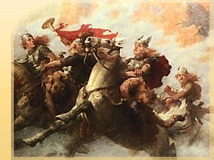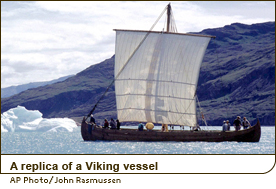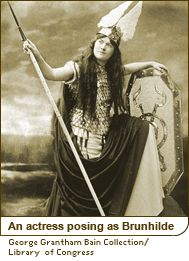

There were once women among the Danes, who dressed as men and devoted every waking moment to the pursuit of war. Those who had force of character or were tall and comely were especially apt to enter into such a life.
—Saxo Grammaticus, History of the Danes, circa 1200 CE
From the eighth century to the eleventh century CE, the Vikings plundered across Britain, Europe, North America and the Far East. These daring explorers left their homes in present-day Norway, Sweden, Denmark and Iceland to sail in treacherous waters, searching for land, slaves and riches. They reached as far as Baghdad and America.
The Vikings’ fierceness is legendary, but they were more than bloodthirsty pirates. They were also explorers, settlers, astute traders and superb shipbuilders. While the stereotypical image of Viking warriors is of big, bearded men wielding battle-axes, archaeological evidence suggests that Viking women were also armed and dangerous.
I Am Woman, Hear Me Roar

Viking women were an independent lot and legally considered equal to men. They could choose their husbands, sue for divorce and exercise rights to inheritance and “blood money” guaranteed by the Gragas, an Icelandic book of laws. The women even participated in the Althing, the world’s oldest parliament. Often, while their husbands were at sea, they would run the households and businesses. Many wives also made the difficult voyage with their husbands to help colonize new lands.
Given Viking women’s powerful position in society, it’s no surprise that Viking mythology features strong women: The women of Viking legends were fierce, vengeful military aggressors. The earliest mythological Viking characters were the Valkyries, heavily armed shield-maidens whose primary duty was to choose the bravest warriors slain in battle and lead them safely to their afterlife in Valhalla. Souls unlucky enough to be deemed unworthy by the Valkyries would be taken to the goddess Hel and doomed to an eternity in the underworld.
The Viking sagas and the writings of historian Saxo Grammaticus—two sources that merge myth and legend with history—are also filled with tales of bloodthirsty warrior women. Saxo wrote of Lathgertha, “a skilled female fighter who bore a man’s temper in a girl’s body with locks flowing loose over her shoulders as she would do battle in the forefront of the most valiant warriors.” In a stroke that illustrates the mythological aspect of Saxo’s work, he also wrote that she could fly. And in describing the tenth-century Bravellir battle between Danes and Swedes, which involved 200,000 soldiers and twelve kings, he wrote of three fearless Viking women—Hetha, Wisna and Webiorg—who fought for the Danish.
One of the most notorious Viking women featured in Viking lore is Freydis Eiriksdottir, the illegitimate daughter of Erik the Red. In the early eleventh century, according to the Saga of the Greenlanders and Erik the Red’s Saga (in Icelandic, Eiriks saga), she was among the Vikings who sailed to Vinland. It is Freydis’ father’s saga that tells of her most heroic act: Upon arrival, they were attacked by natives. While the Viking men ducked for cover, a pregnant Freydis took up her sword, bared her breasts, pounded her chest and shrieked a battle cry with such force that the unnerved natives retreated.
Even Irish tales recount how, in the ninth century, Ireland was terrorized by Ingean Ruadh (also known as Red Maiden), who also participated in battles against Denmark and Iceland.
Armed and Dangerous

According to archaeological findings, Viking women warriors may have existed; at the very least, Viking women were skilled with weapons. In the early 1950s, the remains of eight women were discovered in Sweden, buried in boat graves with swords at their sides. Axes and arrowheads were found in Viking women’s graves at Kaupang, Norway, also during the 1950s. In Gerdrup, Denmark, a skeleton buried with a woman’s needle case and a spear was unearthed in 1981. And as recently as 2001, a Viking grave found in Norfolk, England, revealed a skeleton with feminine brooches and a “sword-like item.” Since Vikings were customarily buried with their prized possessions, these women may have been warriors buried with their weapons so they could fight on in the afterworld.
The most common Viking weapons were long spears, axes and broadswords. Vikings wore chain mail and used round wooden shields for protection. Close, hand-to-hand combat was common. It would have taken a strong woman to wield this heavy weaponry in battle, but according to the tenth-century Islamic historian Ibn Fadlan, the Viking women were well up to the task. He tells us that “strength and physical fitness were prized equally by Viking men and women” and that both competed equally in “glima,” a type of wrestling still popular in Iceland. One ancient Viking saga tells of a match between one man and woman that lasted for days before ending in a draw.

The famed Brunhilde “of breastplate and horned helmet” figures prominently in Norse sagas, as well as in the German thirteenth-century epic poem Nibelungenlied, in which she is sometimes referred to as a Valkyrie. In both traditions, she appears as a mighty warrior who vows to only marry a man who can surpass her in strength. In Wagner’s nineteenth-century opera cycle, Der Ring des Nibelungen (The Ring), a retelling of the Nibelungenlied, Brunhilde is portrayed with ample bosom, chain mail and long blond braids.
There have also been the more eroticized images of Viking women over the centuries, including the 1957 film Viking Women and the Sea Serpent. It took female-Viking lore to new heights of kitsch, portraying scantily clad Viking women battling a sea serpent in an effort to save their men from barbarians.
While there is no concrete evidence placing Viking women on the battlefield, archaeological findings and the prominence of female warriors in Viking lore suggest that they probably did bear arms. And given that, throughout the ages, women of many cultures have fought battles for personal, social and political causes, it’s likely that Viking women, known for their independence and strength, were no exception.
:: Lisa Cooke
Vikings Selected Sources



